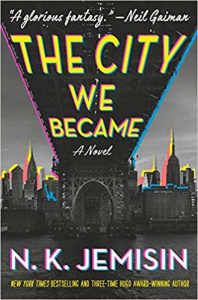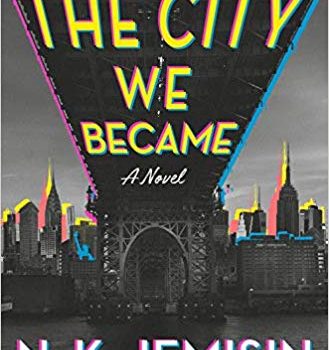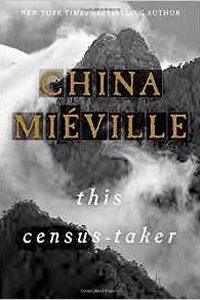Gary K. Wolfe Reviews The City We Became by N.K. Jemisin
 The City We Became, N.K. Jemisin (Orbit 978-0-316-50984-8, $28.00, 448pp, hc) March 2020.
The City We Became, N.K. Jemisin (Orbit 978-0-316-50984-8, $28.00, 448pp, hc) March 2020.
I have no idea whether N.K. Jemisin has read H.P. Lovecraft’s “The Horror at Red Hook”, which is in part Lovecraft’s half-hearted attempt to write a detective story and in part a racist having a panic attack in print, but it was the story that provided the template for Victor LaValle’s The Ballad of Black Tom a couple of years ago, and it works pretty well as a kind of ironic background to her remarkable and cleverly subversive new novel The City We Became. Like LaValle, Jemisin pointedly invokes parts of Lovecraft’s mythos and, like LaValle, she delights in making heroes out of those Lovecraft most deeply despised, but there’s a good deal more going on in the novel than yet another fuck-you to HPL’s baser attitudes. Instead, it’s partly a raucous celebration of New York City itself, with roots that go back as far as Whitman (“Stand up, tall masts of Mannahatta! stand up, beautiful hills of Brooklyn!”) or classic novels like Dos Passos’s Manhattan Transfer; partly a superhero origin story (complete with an extra-dimensional urban invasion like Watchmen‘s alien squid); partly a political fable touching upon everything from white supremacists to real estate chicanery, immigration, and even the ethics of nonprofit fundraising. What makes it all work, however, amid the spectacular surrealistic imagery, rollercoaster plotting, and comic-book effects (including one genuine Hulk moment), is Jemisin’s insightful concern for and understanding of her diverse cast of central characters. This is all the more remarkable because these characters are called upon to serve triple duty: as symbolic avatars, as credible New Yorkers, and as members of an emerging fellowship which must work cooperatively to save the city from those Lovecraftian horrors.
The basic premise, which was previewed in Jemisin’s 2016 story “The City Born Great”, is this: each great city reaches a point in its history when it literally comes alive and is embodied in an avatar who might otherwise seem an ordinary, undistinguished citizen. When this happens, ancient eldritch forces try to use this moment of instability to invade and gain a foothold in our world. It’s never made clear exactly what the tipping point is, but Sao Paulo is the most recent city to waken, so its avatar is sent to offer assistance to New York’s avatar, a homeless young black man who is already being pursued by an otherworldly insectoid monster he calls Mega Cop. Both are temporarily shunted offstage as we meet our main cast, the avatars of the city’s five boroughs: a young grad student who has just arrived in New York and mysteriously lost his memory, who takes the name Manny from Manhattan; a sheltered Staten Islander, Aislyn, who is terrified of the rest of the city; a Bronx art gallery director named Bronca; a former rapper and politician named Brooklyn; and “the Queen of Queens,” Padmili, a Tamil immigrant and skilled mathematician. Obviously, these avatar names are about as subtle as Neil Gaiman literalizing London tube stations in Neverwhere, but Jemisin is careful to keep us from viewing these figures as mere emblems: each faces enough real-world challenges of surviving in New York to ground the novel in characters who’d be almost as compelling without all the fireworks.
The fireworks are pretty hard to ignore, though, and they’re a lot of fun. Each of these figures witnesses strange manifestations of sickly white growths emerging from buildings, streets, and even other New Yorkers, some growing to the size of high-rises, and which can be combated with certain powers that the avatars discover in themselves. These manifestations – whose actual Lovecraftian source we learn late in the novel – have their own avatar in the form of The White Lady, who clearly, if unchecked, will take Manhattan, the Bronx, and Staten Island, too. Much of the action of The City We Became follows a pattern not unfamiliar in the first volume of fantasy trilogies, as the five avatars try to find each other in order to combine forces in a fellowship, and then seek to find and awaken that one city-wide New York avatar, whom they believe to be sleeping somewhere in the city. Along the way they discover their own powers, as well as unexpected heroism and treachery on the part of secondary characters, and eventually find themselves facing apparently hopeless odds. As a standalone narrative, The City We Became offers only a degree of closure in a rather abrupt ending, as Jemisin sets the stage for the epic struggles we can expect in subsequent volumes. As the inaugural volume of what promises to be a wildly original fantasy trilogy, quite unlike anything else Jemisin has written, it completely takes command of the very notion of urban fantasy, and it leaves us exactly where we need to be – wanting the next volume now.
Gary K. Wolfe is Emeritus Professor of Humanities at Roosevelt University and a reviewer for Locus magazine since 1991. His reviews have been collected in Soundings (BSFA Award 2006; Hugo nominee), Bearings (Hugo nominee 2011), and Sightings (2011), and his Evaporating Genres: Essays on Fantastic Literature (Wesleyan) received the Locus Award in 2012. Earlier books include The Known and the Unknown: The Iconography of Science Fiction (Eaton Award, 1981), Harlan Ellison: The Edge of Forever (with Ellen Weil, 2002), and David Lindsay (1982). For the Library of America, he edited American Science Fiction: Nine Classic Novels of the 1950s in 2012, with a similar set for the 1960s forthcoming. He has received the Pilgrim Award from the Science Fiction Research Association, the Distinguished Scholarship Award from the International Association for the Fantastic in the Arts, and a Special World Fantasy Award for criticism. His 24-lecture series How Great Science Fiction Works appeared from The Great Courses in 2016. He has received six Hugo nominations, two for his reviews collections and four for The Coode Street Podcast, which he has co-hosted with Jonathan Strahan for more than 300 episodes. He lives in Chicago.
This review and more like it in the February 2020 issue of Locus.
 While you are here, please take a moment to support Locus with a one-time or recurring donation. We rely on reader donations to keep the magazine and site going, and would like to keep the site paywall free, but WE NEED YOUR FINANCIAL SUPPORT to continue quality coverage of the science fiction and fantasy field.
While you are here, please take a moment to support Locus with a one-time or recurring donation. We rely on reader donations to keep the magazine and site going, and would like to keep the site paywall free, but WE NEED YOUR FINANCIAL SUPPORT to continue quality coverage of the science fiction and fantasy field.








